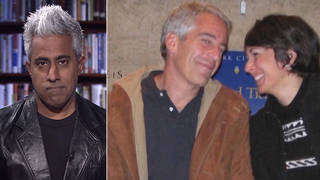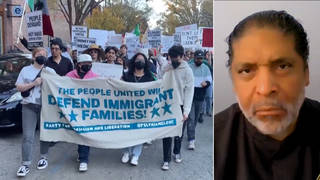
Guests
- John Giblerindependent journalist and the author of Mexico Unconquered: Chronicles of Power and Revolt and, more recently, To Die in Mexico: Dispatches from Inside the Drug War. His upcoming book, in Spanish, is Fue el Estado (It was the State), about the attacks on the students in Iguala.
On September 26, 2014, a group of students from Ayotzinapa teachers’ college came under attack by police in the city of Iguala, in the southern Mexican state of Guerrero. Six people were killed in a series of attacks that night, and 43 students were disappeared. The Mexican government has claimed the 43 students were killed by members of a local drug gang, and their bodies incinerated in a trash dump in the neighboring town of Cocula. But the students’ families have long rejected this account, and the phrase “fue el estado,” or “it was the state,” has become a rallying cry at mass protests across Mexico and around the world. Now, a new independent report commissioned by the Inter-American Commission on Human Rights has dismissed the Mexican government’s version of the students’ disappearance. We speak with journalist John Gibler in Mexico City. He outlines the report’s key findings, including that municipal, state and federal police actively participated in attacks on the students and that military intelligence officers were present at at least two of the attack scenes.
Transcript
AMY GOODMAN: Mexico has announced it will now seek a new investigation into whether 43 students, who disappeared after being abducted by corrupt police officers in southwest Mexico last year, were burned in a dump, after an independent report dismissed the official account. The announcement comes after a team of international experts commissioned by the Inter-American Commission on Human Rights found no evidence to support the government’s claim that the students from the Ayotzinapa teacher college were incinerated in a trash dump in the neighboring town of Cocula. Francisco Cox, one of the five members of the group of experts commissioned by the group, spoke to the unlikelihood that the 43 students could have been burned there.
For more, we go for reaction on the ground to Mexico City, where we’re joined by John Gibler. He’s an independent journalist, author of Mexico Unconquered: Chronicles of Power and Revolt and, more recently, To Die in Mexico: Dispatches from Inside the Drug War. His upcoming book is coming out, called It was the State, about the attacks on the students in Iguala.
John Gibler, welcome to Democracy Now! Talk about the significance of this report and what happened, what’s believed happened, to the students.
JOHN GIBLER: Thank you, Amy. Yes, as you mentioned, the report concluded that the 43 disappeared students were in fact not incinerated at the trash dump in Cocula, which has been the federal government’s line of investigation throughout the entire period of investigation. There are several other major findings of the report I’d like to summarize for listeners and viewers.
One, that the local, state and federal authorities had been monitoring the students since 5:59 p.m. on September 26th as they moved along the highways. This was hours before they ever arrived in Iguala.
Also, they arrived in Iguala almost an hour after the mayor’s wife’s political event had ended, thus there was no possibility that they could have been attacked as a retaliation for attempting to protest that event. It had ended before they arrived, as the students had said from the very beginning.
Three, the report shows that both municipal, state and also federal police actively participated in the attacks against the students, not only monitoring, but once they were in Iguala, both state and federal as well as municipal police participated in the attacks against the students.
The report also found that military intelligence officers were present at at least two of the attack scenes.
The report concludes that a confusion of the students with a supposed drug gang is an unlikely, if not absurd, scenario, because of the massive scale, the complexity, the coordinated nature and the escalating violence, disproportionate use of violence, all employed in the attacks against the students. Again, we have municipal, state and federal police actively participating in the attacks at nine different locations over more than three hours inside the city of Iguala, with the army watching all the time.
The report also found that the federal government had systematically destroyed key evidence, two pieces that are very important. One, the video footage from federal security cameras that completely recorded one of the scenes of the attacks from which students were disappeared from a bus, that video—that video was recovered and then destroyed by someone inside the government. Two, one of the buses, the key buses involved in the attack, what the experts are calling the fifth bus, was disappeared itself. That bus has not been located. When the experts asked to view that bus, they were presented with a different bus that had been made up to look like it, one of their independent expert studies—
AMY GOODMAN: John, we have 10 seconds. How has the family responded, and will the Mexican government open a new investigation?
JOHN GIBLER: They will open a new investigation. The family has fully embraced the report and also announced the government for torturing them. They said that “this theory of the trash dump has been torture for us.” And they are fully supporting the report.
AMY GOODMAN: John Gibler, I want to thank you for being with us. We’ll continue to follow this story of the 43 missing students in [Mexico].













Media Options